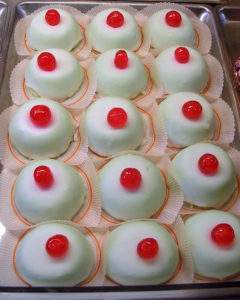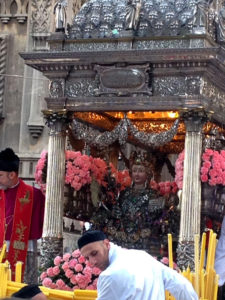My sister and I were chatting on the phone yesterday morning and during the call, she remembered it was time for Minne di Vergine, the pastries made once a year for St. Agatha’s Day. I had forgotten. It’s been a busy, hectic Saturday, but here I am late Saturday night, past midnight, gathering some thoughts for you in an essay for the day. It’s a bit of writing taken from past chapters on St. Agatha’s Day, mixed with some new things I’ve learnt over the years… but at this late hour, there’s not enough time to give you a brand new chapter without denying myself a full night’s sleep, so please, take this as it is –– cobbled together –– with the blessing, I hope, of Sant’Agata.
Type the Italian word minne into Google Translator and ask it to translate to English and you may get exactly what I got: minne –– the same word, repeated. Google did not see fit to translate such a word. But we’re all adults here, so I will translate for you: the word minne is the Italian equivalent of any number of English slang words for breasts: boobs, tatas… you can take your pick from a very long list. This all brings us to one of the oddest days in the seasonal round: St. Agatha’s Day, when Sicilian bakeries prepare a once-a-year sweet delicacy known as Minne di Vergine –– Virgin’s Breasts –– pastries that were invented by the nuns of Catania for us to savor with our espresso.
Saint Agatha, or Sant’Agata in Italian, lived in Catania in Sicily in the third century; she is sacred to those places, especially to Catania. The pastries are made from sponge cake with a mound of sweet ricotta cream on top, covered in marzipan and dotted, just where you would expect it to be, with a cherry. You may blush as you eat them, but the pastries come from the story of Agatha’s martyrdom for her faith: The Roman governor of Catania became enthralled with Agata’s beauty. Agata, however, one of the secret upstart Christians in town, had taken a vow of chastity to protect her virginity. The Roman governor would have none of it, though, and continued his advances. Agata continued to reject him to protect her faith… and for this she was sentenced to death by the governor. He had her killed in a gruesome manner that it pains me to describe for you. Yet I fear I must… for it’s the only reason these delicious Minne di Vergine make any sense: he had Agata’s breasts severed before roasting her above a bed of live coals. I told you it was gruesome.
The story is not for the faint of heart. But at its heart is a strong woman who did not back down and who did not surrender her principles and who stood up to a man, and that is pretty powerful stuff, especially in the year 251. Sant’Agata is now patroness of Catania. She is invoked for protection from breast disease as well as from volcanic eruptions. It was the nuns of Catania who began baking the confections that we enjoy each Fifth of February, something they’ve been doing for centuries. It’s part of what makes Catholicism so incredibly fascinating, especially in Italy. Marzipan pastries in the shape of breasts made by Catanese nuns? This is probably a big part of what makes Protestants so nervous around us Catholics, even to this day. We are a somewhat dramatic people.
The celebration in Catania has been going on for a few days now, but it all culminates tonight with processions through the city of large carriages and spectacular candelore––enormous towers with lit candles depicting scenes from St. Agatha’s life. The candelore are paraded and danced through the streets of Catania to shouts of “Evviva Sant’Agata!” by men in full costume, the towers hoisted upon their shoulders. (Again, not for the faint of heart.)
Tradition would have us eat never just one minna, but always two: since breasts come in pairs, so it goes with these pastries. So that means each person eats two minne, two pastries… so even this is not for the faint of heart.
I love when there are literary connexions to the foods we eat, and my Italian professoressa, Myriam Swennen Ruthenberg, should she be reading this, might be thinking now of a famous scene in Giuseppe di Lampedusa’s novel Il Gatopardo (The Leopard, in its English translation) in which Don Fabrizio looks over a vast table of Sicilian desserts that include these Minne di Vergine, the breasts of St. Agatha. He asks for some and receives them (two, no doubt) and he beholds them on his plate. He thinks of the famous paintings of St. Agatha presenting her own severed breasts on a plate. He asks, “Why ever didn’t the Holy Office forbid these puddings when it had the chance?”
And so today I hope you can find at an Italian bakery some Minne di Vergine. You don’t need to blush when you order them; just point, perhaps whisper the word “minne,” pay and go. Be sure to order them in pairs.
If you prefer to make your own Minne di Vergine (or are too embarrassed to ask for them at your local Italian bakery), here is a recipe for Minne di Vergine that we’ll be trying next chance we get. The photograph of the pastries was shot in Catania and is by Stefano Mortellaro, 2005 [Creative Commons] via Wikimedia Commons. The photograph of the statue of Sant’Agata comes to us thanks to my Sicilian friend Luisa Mangano-Johnson. Grazie mille, Luisa!
SHOP OUR VALENTINE SALE!
Spend $85 across our catalog and take $10 off, plus get free domestic shipping, when you enter discount code LOVEHANDMADE at checkout. That’s a total savings of $19.50. Click here to start shopping. We’ve got some wonderful new handmade artisan goods from Mexico, as well as brand new handmade Murano glass dipping pens and lovely writing papers from Italy. Your purchases at conviviobookworks.com translate into real support for real families, small companies, and artisans we know by name. We all appreciate your support!



